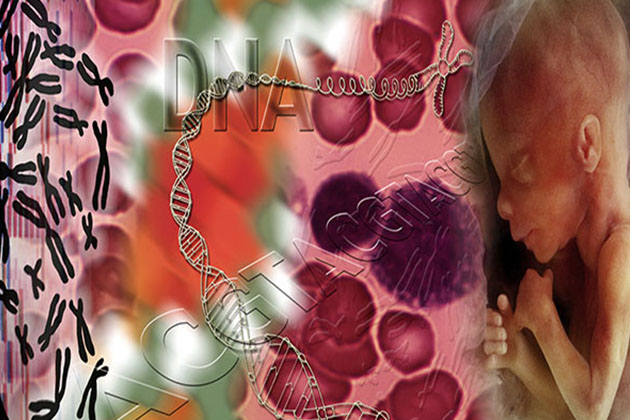Utafiti unaonyesha ahadi ya kutibu ugonjwa wa maumbile katika mamalia wakati wa ukuaji wa fetasi katika miezi mitatu ya kwanza ya ujauzito
A maumbile machafuko ni hali au ugonjwa unaosababishwa na mabadiliko yasiyo ya kawaida au mabadiliko ya DNA ya mtu katika jeni. Yetu DNA provides the required code for making proteins which then perform most of the functions in our body. Even if one section of our DNA gets altered in some way, the protein associated with it can no longer carry out its normal function. Depending upon where this change happens either it can have a little or no effect or it might alter the cells so much that it could then lead to a maumbile disorder or illness. Such changes are caused by errors in DNA replication (duplication) during growth, or environmental factors, lifestyle, smoking and exposure to radiation. Such disorders are passed on to the offspring and start to occur when the baby is developing in mother’s uterus and are therefore referred to as ‘birth defects’.
Birth defects can be minor or extremely severe and may affect appearance, function of an organ and some aspect of physical or mental development. Millions of children are born annually with serious maumbile conditions. These defects can be detected during pregnancy as they are evident within the first three months of pregnancy when the organs are still forming. A technique called amniocentesis is available for detecting maumbile abnormalities in the foetus by testing amniotic fluid extracted from the uterus. However, even with amniocentesis, treating them is not possible as no options are available to make any corrections before birth of the baby. Some of the defects are harmless and require no intervention but some others can be of serious nature and may require long-term treatment or even be fatal for the infant. Some defects can be corrected shortly after birth of the baby – example within a week’s time – but mostly it is too late for treatment.
Kuponya maumbile condition in an unborn baby
For the first time the revolutionary gene editing technique has been used to cure a ‘maumbile disorder’ in mice during foetal development in the uterus in a study by researchers at Carnegie Mellon University and Yale University. It is well established that during early development in the embryo (during first three months of a pregnancy) there are many stem cells (an undifferentiated cell type which can become any type of cell upon maturation) that are dividing at a fast rate. This is the pertinent time point where a maumbile mutation if corrected would reduce the impact of the mutation on embryo-to-foetal development. There are chances that a severe maumbile condition could even be cured and the baby is born without the unintended birth defects.
Katika utafiti huu uliochapishwa katika Hali Mawasiliano researchers have used a peptide nucleic acid-based gene editing technique. This technique has been used before to treat beta thalassemia – a maumbile blood disorder in which haemoglobin (HB) produced in the blood is reduced considerably which then affects normal oxygen supply to various parts of the body leading to severe abnormal consequences. In this technique, unique synthetic molecules called peptide nucleic acids (PNAs) (made of a combination of synthetic protein backbone with DNA and RNA) were created. A nanoparticle was then used to transport these PNA molecules along with “healthy and normal” donor DNA to the location of a maumbile mutation. The complex of PNA and DNA identifies the designated mutation at a site, PNA molecule then binds and unzips the double helix of mutated or faulty DNA. Lastly, donor DNA binds with the mutated DNA and automates a mechanism to correct the DNA error. The main significance of this study is that it was done in a foetus, thus researchers had to use a method analogous to amniocentesis wherein they inserted the PNA complex into the amniotic sac (amniotic fluid) of pregnant mice whose foetuses were carrying the gene mabadiliko ambayo husababisha thalassemia ya beta. Baada ya sindano moja ya PNA, asilimia 6 ya mabadiliko yalirekebishwa. Panya hawa walionyesha kuimarika kwa dalili za ugonjwa huo yaani viwango vya hemoglobini vilikuwa katika viwango vya kawaida ambavyo vinaweza kufasiriwa kama panya 'walioponywa' hali hiyo. Pia walionyesha kuongezeka kwa kiwango cha kuishi. Sindano hii ilikuwa katika anuwai ndogo sana lakini watafiti wana matumaini kwamba viwango vya juu zaidi vya mafanikio vinaweza kupatikana ikiwa sindano zilifanywa mara nyingi.
Utafiti huo ni muhimu kwa sababu hakuna malengo ambayo hayakulengwa yalibainishwa na ni DNA inayohitajika pekee ndiyo iliyosahihishwa. Mbinu za uhariri wa jeni kama CRISPR/Cas9 ingawa ni rahisi kutumia kwa madhumuni ya utafiti, bado ina utata kwa sababu inakata DNA na kutekeleza makosa ya nje ya tovuti kwani yanaharibu DNA ya kawaida isiyolengwa pia. Kwa sababu ya kizuizi hiki, hazifai kabisa kwa kubuni matibabu. Kwa kuzingatia jambo hili, njia iliyoonyeshwa katika utafiti wa sasa inafunga tu kwa DNA inayolengwa na kuitengeneza na inaonyesha makosa ya kutokuwepo. Ubora huu unaolengwa huifanya kuwa bora kwa matibabu. Mbinu kama hiyo katika muundo wake wa sasa inaweza pia kutumika kwa uwezekano 'kuponya' hali zingine katika siku zijazo.
***
{Unaweza kusoma karatasi asili ya utafiti kwa kubofya kiungo cha DOI kilichotolewa hapa chini katika orodha ya (vyanzo) vilivyotajwa}
Chanzo (s)
Ricciardi AS et al. 2018. Katika utoaji wa utero nanoparticle kwa uhariri wa jenomu mahususi wa tovuti. Hali Mawasiliano. https://doi.org/10.1038/s41467-018-04894-2
***






































